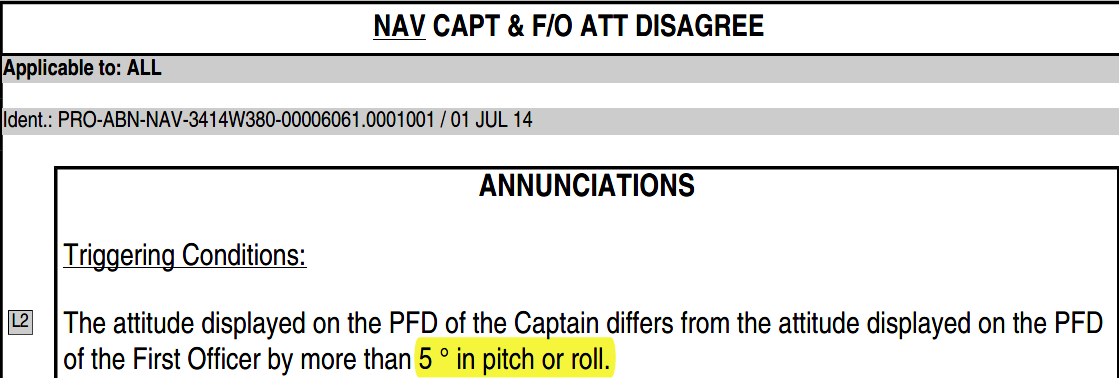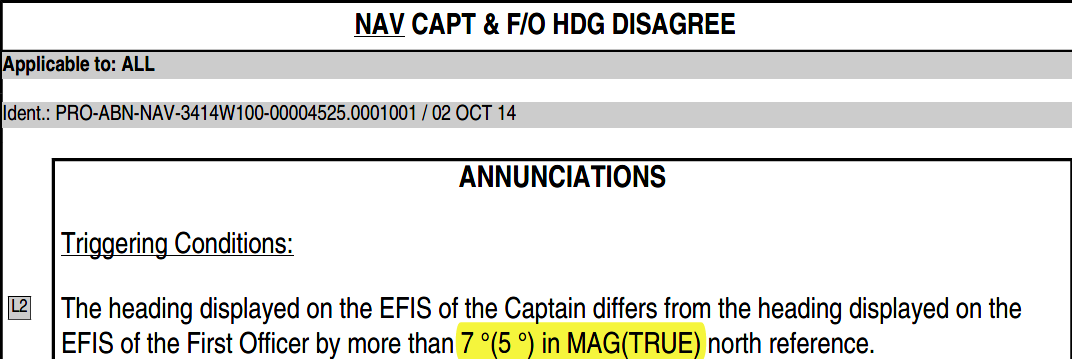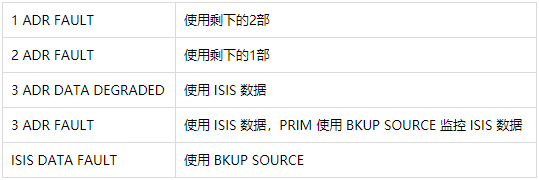NAV CAPT & F/O ATT DISAGREE 以及 NAV CAPT & F/O HDG DISAGREE 这两个 ECAM 警告是 FWS 触发的,条件是“俯仰或滚转显示超过5°”“航向显示超过7°磁航向或者5°真航向”,而程序就只有“机组意识”。对此有两点疑问:
- 这个触发值是否超过任何 ADIRU 警告的阈值?
- 机组是否无需做任何检查,如对比 ISIS?
空客回复说,IR 数据被 PRIM 监控,并传输给 CDS 用于 PFD 上的显示,而这个显示的内容又被 FWS 监控。FWS 触发警告的阈值等于或者大于 PRIM 拒选 IR 的阈值,一般来说,在 FWS 警告出现之前或同时,有问题的 IR 就被 PRIM 拒选了,从而两部 PFD 上显示差别就消失了。所以,FWS 触发的警告要么不会出现,要么只出现很短的时间。然而,某些特定情况会只影响 IR 在 PFD 上的显示数据,所以并不会导致被 PRIM 拒选,此时 FWS 的警告就能够给机组提供必要的意识。
在 FCOM DSC-34-NAV-20-10-50 A ADIRS MONITORING 中,对此有较详细的说明:
ADIRS可以提供数据给很多飞机系统: ADIRU, PRIM, FADEC, FWS等。每个系统都能监控所接受的数据,并能在需要的时候拒选或者重用某些数据。
ADIRU 监控是数据源硬件本身,触发的是硬件故障警告:
- NAV ADR 1(2)(3) FAULT
- NAV ADR 1+2(1+3)(2+3) FAULT
- NAV ADR 1+2+3 DATA DEGRADED
- NAV ADR 1+2+3 FAULT
- NAV IR 1(2)(3) FAULT
- NAV IR 1+2(1+3)(2+3) FAULT
- NAV IR NOT ALIGNED
- NAV ISIS FCUB BARO REF DISAGREE
PRIM 监控的是用于飞控法则计算,以及传输给 CDS 用于显示的数据,触发的是飞控相关警告:
- AUTO FLT A/THR OFF
- AUTO FLT AP OFF
- F/CTL DIRECT LAW (PROT LOST)
- NAV AIR DATA REDUNDANCY LOST
- NAV AOA DISAGREE
- NAV ISIS ALT(ATT)(SPD) UNRELIABLE
- NAV ISIS ALT(SPD) RECOVERED
- SURV REACTIVE W/S DET FAULT
用于飞控计算的数据一旦拒选就不再重用,用于 CDS 显示的则可以在数据恢复正常后可以重用。CDS 显示重构逻辑如下:
FADEC 监控 ADIRU 计算的数据,与发动机传感器得到的参数计算出的数据对比,用于选择数据源。
FWS 监控左右两侧的姿态、航向、气压基准及气压值等,超过阈值则触发警告,算是从结果上来监控,比如:
- NAV CAPT & F/O ATT DISAGREE
- NAV CAPT & F/O HDG DISAGREE
- NAV GNSS/ACFT POS DISAGREE
- NAV CAPT & F/O BARO VALUE DISAGREE
- NAV CAPT & F/O BARO REF DISAGREE
具体回复请参考 TechRequest 原文:
Q:
NAV CAPT & F/O ATT DISAGREE
&
NAV CAPT & F/O HDG DISAGREE
Are the threshold of these two alerts triggered by FWS (5 ° in pitch or roll, 7 °(5 °) in MAG(TRUE) ) not over the threshold of alerts triggered by ADIRU? And can crew compare the the PFD with ISIS to determine which one is correct?
A:
CAPT AND F/O ATT DISAGREE:
- Initially Pitch slightly increases, when the threshold of 5 DEG is exceeded, Pitch returns to normal again (automatic IR switching), CREW awareness
- On E/WD, NAV RNP AR CAPABILTY DOWNGRADED message is displayed, on DISPATCH page, NAV IR 1(2)(3) REJECTED BY PRIM is displayed,. NO need to cross check Attitudes between PFD/ISIS
CAPT AND F/O HDG DISAGREE (SINGLE MALFUNCTION):
- Initially HDG drifts slowly on PFD, when the threshold 7 DEG in MAG or 5 DEG in TRUE is exceeded HDG returns to normal (automatic IR switching), crew awareness
- On E/WD, AUTO FLT APPROACH CAPABILTY DOWNGRADED and NAV RNP AR CAPABILTY DOWNGRADED message is displayed, NO need to cross check HDG with ISIS and or STDBY Compass
Q_2:
In your answers, once pitch exceeds 5 DEG (HDG exceed 7/5 DEG) wich are the same with triggering threshold of NAV CAPT & F/O ATT DISAGREE & NAV CAPT & F/O HDG DISAGREE, it will return to normal and trigger other alerts. Does that mean these 2 alerts will disappear when parameters return to normal just after triggered? So what are the use of these alerts?
A_2:
IR data are sent to PRIM computers via ARINC 429 buses. The PRIM computers compare these data, and may reject one or more IR sources if they disagree. The monitoring thresholds defined at PRIM level depend on the flight conditions. If an IR source is rejected by PRIM, it will no longer display data on CDS.
IR data displayed on CDS are primarily sent via AFDX network. The FWS compares these data. FWS monitoring thresholds are constant, and are either equal or higher than the PRIM monitoring thresholds.
This means that the IR data monitorings perfomed at PRIM level and FWS level are independent.
In the most probable case of an IR failure leading to general IR data discrepancy, the PRIM monitoring will trigger first, leading to IR source switching. In this case, the FWS monitoring will not trigger, or will trigger for a very short period of time.
However, some specific failure cases may only affect the IR displayed data, without leading to an automatic source switching. In such situation, it is necessary to provide awareness to the crew. This is the aim of NAV CAPT & F/O ATT(HDG) DISAGREE alert.



